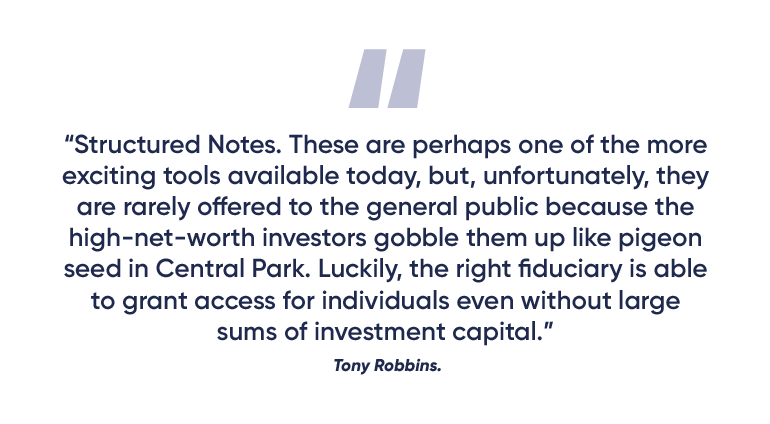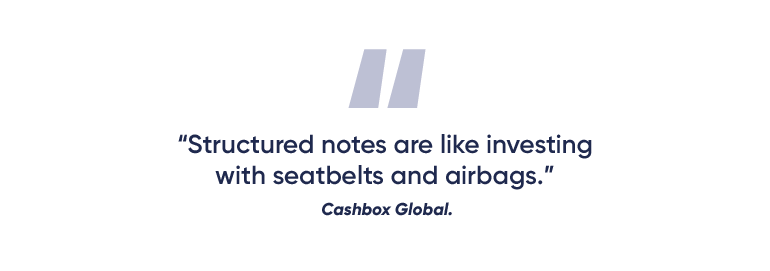
Explore the highlights of digitalisation’s impact on structured notes
As technology continues to expand the FinTech industry, investors now have more personalised options for investments in the form of structured notes. Structured notes were typically behind a barrier of unaffordability for everyday investors with only the wealthiest able to invest due to having enough capital to meet the minimum deposit requirements.

Spurring on the evolution of structured notes is that businesses are prioritising digital transformation in 2022, with a staggering 65% increase from last year.1 This was published in EY’s Parthenon 2022 Digital Investment Index (DII), which surveyed 1,500 global C-level executives worldwide from January 2022 to March 2022.
Below are the main highlights from this survey:2
- Digital transformation is viewed as an essential business imperative and crucial to survival.
- Success relies on achieving the correct balance of organic and inorganic investment vehicles.
- The optimistic uptake of this by executives is based on the idea that spending increases will nearly double their return on digital investments (RODI) in comparison to 2021.
- More businesses are now tracking RODI, but this is a slow process, with many unsure of what was spent or the value of its yield.
- A select group in this digital transformation space (digital performance leaders) are advancing the momentum for and pursuing digital investment successfully.
Evolution of structured products
The important reason for the evolution of structured notes lies in the fact it allows retail investors to have access to higher returns, which fixed income options may not be able to offer. Technology now provides the tools and calculations for even the most structured products that are not traditional financial products, and in fact, fall into the derivatives category.
In a market where traditional asset classes were more dominant, one of the previous issues with buying structured notes was when it came to assessing risk with stress testing and scenario analysis, was the lack thereof. This is an important part of an investor’s portfolio as this allows the financial product to predict whether it will assist in reaching the investor’s goal.
Investopedia defines this as, “the process of estimating the expected value of a portfolio after a given change in the values of key factors take place.”3 Where computer algorithms can run a simulation of worst-case situations or events and give a projection of this.
Beginning of structured products
Let’s take a brief glance at the humble origins of structured products as sourced from SRP. Structured products answered a solution for retail investors by providing, “a way of accessing stock market returns without risking capital”.4
In the 1980s, structured products were sold in France first, and the technology rapidly spread to the United Kingdom. This market’s burgeoning expansion soon encompassed Asia in the 1990s.5 The result is these financial products are currently established investment vehicles throughout the world – available from leading banks, financial institutions, insurance groups, and other businesses.
Power of tech-driven innovation
Even back in 2015, the global financial crisis on structured products prompted the financial industry to find solutions to overcome the inefficiencies of the market.6 This included finding ways to simplify the creation and implementation of these investment vehicles.
- The optimal customised structured product7
Automation and streamlining of the processes of issuing structured notes have been a years-long focus, with the emergence of new digital tools and platforms. Not only does this allow the issuer to offer better pricing guidelines and lower costs along with automation enhancements – but this also provides customised solutions for each investor. The addition of tailoring each structured product to an investor’s unique preferences has made this a scalable solution and added to the growth and allure of structured products. - Mass customisation is now possible8
Tech has enabled the possibility of mass customising a structured product, powered by investment algorithms that can match investor preferences with a click of a button, and in mere seconds. In comparison to when structured products were first available for investment, this type of functionality used to take a full day to compute.
The growth of structured products has received a definite boost with advances in tech. According to Bloomberg, the potential of this industry in the retail sector is remarkable. In 2019 structured products made up 1% of $700 trillion (USD) – the total value of assets – in global financial markets.9
Even if one considers the hedge fund industry and exchange-traded funds (ETFs), the combined notional value of institutional and retail commitments is more than double both of those factors.10 This shows that structured notes as an investment vehicle for investors are a powerful tool and that investors should be devoted to having a greater understanding of how they work.
Adding structured notes to an investment portfolio
In keeping with the modern portfolio theory of lowering market volatility through diversification,11 booming interest in structured notes has given rise to companies that solely focus on this investment asset class. Our partner Cashbox Global is a financial services organisation registered with the Financial Services Commission in Mauritius providing global investors access to international structured notes. Cashbox Global does not offer investment advice nor make any recommendations regarding investments.
Their perspective on structured notes is that structured notes offer a range of benefits that appeal to institutional and retail investors. The reason for this is that structured notes are more flexible assets that can be personalised to an investor’s risk/return profile and investment goals.

Wealth Migrate firmly believes that structured notes are a good solution for portfolio diversification and that an investor should ideally include a mix of alternative assets and traditional assets. Every investor should educate themselves on the risks and returns of their investment portfolio and make informed decisions – whether this is with the assistance of a financial planner, through self-evaluation, or a combination of both.
As part of an ongoing educational series, our next article will delve into the emergence of co-living as an asset class and analyse the rise in demand for such assets.
1 Wang, J., McGarrity, L., and Ulrich, P., et al (April 2022). ‘How can your digital investment strategy reach higher returns?’. Retrieved from EY.
2 Wang, J., McGarrity, L., and Ulrich, P., et al (April 2022). ‘How can your digital investment strategy reach higher returns?’. Retrieved from EY.
3 Hayes, A. (May 2022). ‘Investing: portfolio management’. Retrieved from Investopedia.
4 Structured Retail Products. (2022). ‘History of structured products’. Retrieved from SRP.
5 Structured Retail Products. (2022). ‘History of structured products’. Retrieved from SRP.
6 Hubbis. (July 2015). ‘Panel highlights tech platforms to evolve structured product offering’. Retrieved from Hubbis.
7 Jashari, B., Johnson, P., and Schumann, N., et al. (August 2019). ‘In one click to the optimal individualized structured product’.Retrieved from SwissQuant.
8 Julius Baer. (September 2019). ‘A digital supermarket for structured products’. Retrieved from Julius Baer.
9 Fara, K. (October 2019). ‘Sure time to grasp the potential of structured products’. Retrieved from Bloomberg.
10 Fara, K. (October 2019). ‘Sure time to grasp the potential of structured products’. Retrieved from Bloomberg.
11 Meyer, E. (November 2020). ‘Why structured notes are one of the most innovative options to come out since the mutual fund’. Retrieved from Worth.